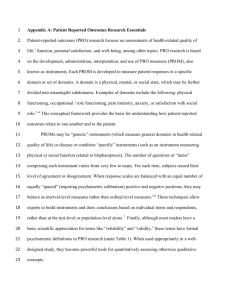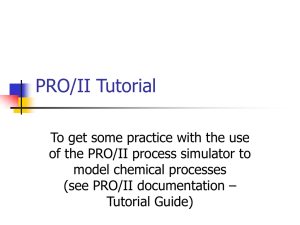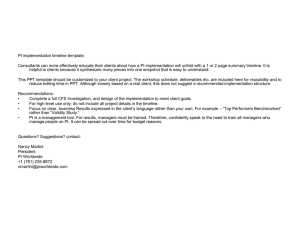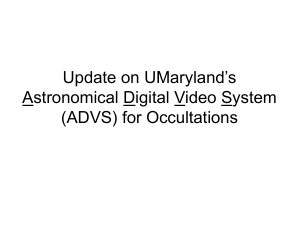presentation_6-18-2012-21-45-48
advertisement
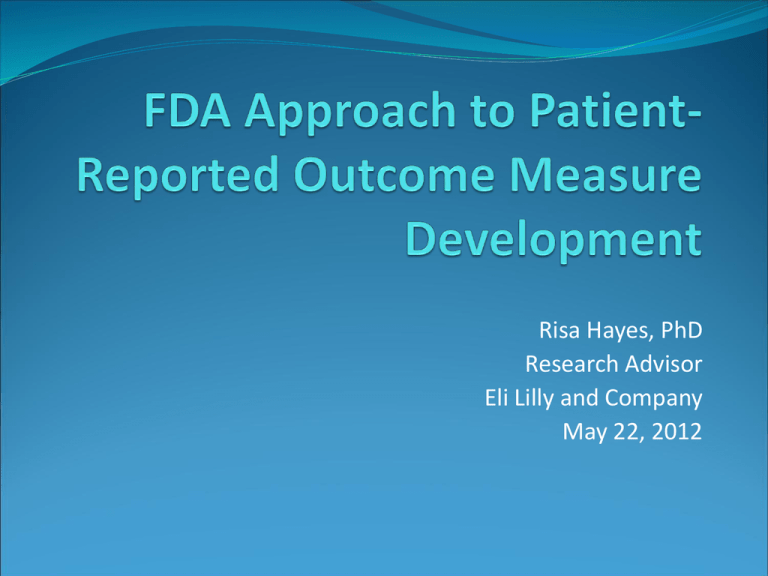
Risa Hayes, PhD Research Advisor Eli Lilly and Company May 22, 2012 Patient-Reported Outcome (PRO) Measures A patient-reported outcome (PRO) is any report of the status of a patient’s health condition that comes directly from the patient, without interpretation of the patient’s response by a clinician or anyone else. A PRO instrument is used to measure treatment benefit or risk in medical product clinical trials. A PRO is a clinical outcome assessment (COAs) Patient-reported outcome assessments (PROs) Clinician-reported outcome assessments (ClinROs) Observer-reported outcome assessments (ObsROs) 2 URINARY INCONTINENCE Labeling claim for ANTUROL Claim first approval:07 December 2011 Patients treated with ANTUROL (84 mg) experienced a statistically significant decrease in the number of urinary incontinence episodes per week from baseline to endpoint (the primary efficacy endpoint) compared with placebo (p=0.0445) and patients treated with the 56 mg dose did not show statistically significant efficacy. Statistically significant improvements in daily urinary frequency (p=0.0010) and urinary void volume (p<0.0001) were also seen with ANTUROL (84 mg) relative to placebo. The mean difference from placebo for ANTUROL (84 mg) was -2.3 for urinary incontinence episodes per week in a group of patients with a mean of greater than 40 incontinence episodes per week at baseline. Mean and median change from baseline in weekly incontinence episodes (primary endpoint), daily urinary frequency, and urinary void volume (secondary endpoints) between placebo and ANTUROL are summarized in Table 3. Source: PROLabels PRO Measures to Support Labeling The Food and Drug Administration (FDA) reviews and evaluates existing, modified, or newly created patient-reported outcome (PRO) instruments to support labeling claims Two methods for development of PRO instruments but one standard of evidence PRO Instrument Development to Support Labeling Claims NDA/IND process? DDT Qualification process? Guidance for Industry Guidance for Industry Patient-Reported Measures: Use in Medical Product Development to Support Labeling Claims Patient-Reported Measures: Use in Medical Product Development to Support Labeling Claims Guidance for Industry Qualification Process for Drug Development Tools PRO Consortium Industry Members Working Groups Asthma Abbott Laboratories Actelion Pharmaceuticals Ltd. Amgen Inc. Astellas Pharma US, Inc. AstraZeneca Pharmaceuticals Boehringer Ingelheim Pharmaceuticals, Inc. Bristol-Myers Squibb Company Daiichi Sankyo, Inc. Eisai Eli Lilly & Company Forest Research Institute GlaxoSmithKline Ironwood Pharmaceuticals, Inc. Janssen Pharmaceutical Companies of Johnson & Johnson Merck Sharp & Dohme Novartis Pharmaceutical Corporation Novo Nordisk, Inc. Pfizer, Inc. Roche Sanofi Shire Corp. Sunovion Pharmaceuticals Inc. Takeda Pharmaceuticals US UCB Pharma Ltd. Cognition Depression Functional Dyspepsia Irritable Bowel Syndrome Non-Small Cell Lung Cancer Rheumatoid Arthritis Team for PRO Measure Development Medical Regulatory Outcomes research Statistics Data management Marketing PRO Instrument Development within an Individual Drug Development Program Pre-IND/Phase 1 Define Concept of Measurement and Context of Use Phase 2A Establish Content Validity (e.g., Qualitative Research, Mixed Methods) Phase 2B Phase 3 Establish other measurement properties (e.g., Quantitative Longitudinal Research) NDA Submission PRO dossier submitted as part of NDA/IND 8 Treatment Benefit The impact of treatment on how patients survive, feel, or function • Efficacy (e.g., improvement or delay in the development of symptoms) • Comparative safety (e.g., reduction or delay in treatment-related toxicity) 9 Concept of Measurement to Support Direct Evidence of Treatment Benefit Disease-defining concepts Core signs, symptoms or decrements in functioning Proximal disease Impact concepts General psychological functioning Related functioning Related S/Ss Proximal concept to treatment benefit Distal disease Impact concepts Additional functioning Additional S/Ss Disease impact on general life concepts Productivity Health status General physical functioning Social functioning Health-related quality of life Satisfaction with health Distal concept to treatment benefit Example: Direct Evidence of Treatment Benefit in Non-Small Cell Lung Cancer* Disease –defining concepts Proximal disease impact concepts Weight loss Cough Shortness of breath Shoulder Pain Chest Pain Tightness in chest Difficulty breathing Anxiety Decreased appetite Difficulty swallowing Memory Concentration/clarity of thinking Depression Hoarseness Sleep disturbance Phlegm Wheezing Swelling of the face/neck Proximal concept to treatment benefit Distal disease impact concepts Ambulation Lack of energy Loss of stamina Distal impact on general life concepts Social functioning Overall impact on HRQL Life interference Helplessness/ hopelessness Independence Difficulty with activities of daily living Distal concept to treatment benefit * Concepts identified through a cursory review of the literature. Graph will evolve based on findings from qualitative research and clinician expertise * Graph does not include concepts measured by biomarkers, ClinRO measures, or ObsRO measures Context of Use Disease definition Target subpopulation (age, disease severity) Clinical trial design and objectives (targeted claim) Geographic location of the study sites Language and culture Clinical practice variations Other (e.g., format) 12 Endpoint Model An Endpoint Model displays the role and hierarchy of relevant outcome concepts in clinical trials (i.e., all primary and secondary endpoints) Endpoints hierachy Primary Concepts Concept A Weight loss Secondary with Hierarchy Concept B Blood pressure Concept C Ability to do physical activities Exploratory Concept D Self-esteem COA/Biomarker/Survival OA 1 % weight lost from baseline to endpoint in kg OA 2 Systolic/diastolic OA 3 New PRO instrument Other OA New PRO instrument 13 PRO Instrument Development within an Individual Drug Development Program Pre-IND/Phase 1 Define Concept of Measurement and Context of Use Phase 2A Phase 2B Phase 3 NDA Submission Establish Content Validity (e.g., Qualitative Research, Mixed Methods) 14 “Well Defined and Reliable” Measurement Properties Documented in the targeted context of use Content validity Includes qualitative research in target population of responders May include quantitative methods (e.g., Rasch, IRT, classical test theory) to assess item function Established before study of other measurement properties 15 Mixed Methods Approach to Assuring Content Validity Quantitative methods Content validity state – exploratory Psychometric analysis stage – confirmatory Sample Size Considerations Samples as small as 30 individuals can provide useful descriptive information Multivariate methods, such as factor analysis can require larger samples PRO Instrument Development within an Individual Drug Development Program Pre-IND/Phase 1 Define Concept of Measurement and Context of Use Phase 2A Establish Content Validity (e.g., Qualitative Research, Mixed Methods) Phase 2B Phase 3 NDA Submission Establish other measurement properties (e.g., Quantitative Longitudinal Research) 17 “Well Defined and Reliable” Measurement Properties Documented in the targeted context of use Content validity Includes qualitative research in target population of responders May include quantitative methods (e.g., Rasch, IRT, classical test theory) to assess item function Established before study of other measurement properties Construct validity Reliability (most critical: test-retest for PRO assessments) Sensitivity to change (consistent with study objectives) Responder definition 18 PRO Instrument Development within an Individual Drug Development Program Pre-IND/Phase 1 Define Concept of Measurement and Context of Use Phase 2A Establish Content Validity (e.g., Qualitative Research, Mixed Methods) Phase 2B Phase 3 Establish other measurement properties (e.g., Quantitative Longitudinal Research) NDA Submission PRO dossier submitted as part of NDA/IND 19 Use of a Qualified COA in a Drug Development Program Pre-IND/Phase 1 Phase 2A Phase 2B Phase 3 NDA/BLA NDA Submission Submission Reference to the DDT PRO qualification specific guidance and submit as part of NDA/IND Define Concept(s) & Context of Use Qualified DDT COA in its targeted context of use 20 Thank you.



